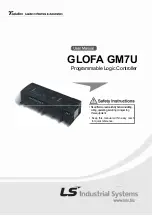
If the status bit is clear, the read-modify-write completed successfully. If the status bit is set, no
write was performed, which indicates that the value returned at step 1 might be out of date. The
software must retry the entire read-modify-write sequence.
Software can use the synchronization primitives to implement a semaphore as follows:
1.
Use a Load-Exclusive instruction to read from the semaphore address to check whether the
semaphore is free.
2.
If the semaphore is free, use a Store-Exclusive to write the claim value to the semaphore
address.
3.
If the returned status bit from step 2 indicates that the Store-Exclusive succeeded, then the
software has claimed the semaphore. However, if the Store-Exclusive failed, another process
might have claimed the semaphore after the software performed step 1.
The Cortex-M4F includes an exclusive access monitor that tags the fact that the processor has
executed a Load-Exclusive instruction. The processor removes its exclusive access tag if:
■ It executes a
CLREX
instruction.
■ It executes a Store-Exclusive instruction, regardless of whether the write succeeds.
■ An exception occurs, which means the processor can resolve semaphore conflicts between
different threads.
For more information about the synchronization primitive instructions, see the Cortex™-M4 instruction
set chapter in the
ARM® Cortex™-M4 Devices Generic User Guide (literature number
.
2.5
Exception Model
The ARM Cortex-M4F processor and the Nested Vectored Interrupt Controller (NVIC) prioritize and
handle all exceptions in Handler Mode. The processor state is automatically stored to the stack on
an exception and automatically restored from the stack at the end of the Interrupt Service Routine
(ISR). The vector is fetched in parallel to the state saving, enabling efficient interrupt entry. The
processor supports tail-chaining, which enables back-to-back interrupts to be performed without the
overhead of state saving and restoration.
Table 2-8 on page 115 lists all exception types. Software can set eight priority levels on seven of
these exceptions (system handlers) as well as on 106 interrupts (listed in Table 2-9 on page 116).
Priorities on the system handlers are set with the NVIC
System Handler Priority n (SYSPRIn)
registers. Interrupts are enabled through the NVIC
Interrupt Set Enable n (ENn)
register and
prioritized with the NVIC
Interrupt Priority n (PRIn)
registers. Priorities can be grouped by splitting
priority levels into preemption priorities and subpriorities. All the interrupt registers are described in
“Nested Vectored Interrupt Controller (NVIC)” on page 136.
Internally, the highest user-programmable priority (0) is treated as fourth priority, after a Reset,
Non-Maskable Interrupt (NMI), and a Hard Fault, in that order. Note that 0 is the default priority for
all the programmable priorities.
Important:
After a write to clear an interrupt source, it may take several processor cycles for the
NVIC to see the interrupt source deassert. Thus if the interrupt clear is done as the last
action in an interrupt handler, it is possible for the interrupt handler to complete while
113
June 18, 2014
Texas Instruments-Production Data
Tiva
™
TM4C1294NCPDT Microcontroller
















































